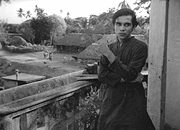While not as overtly political as contemporary filmmaker Mrinal Sen, Satyajit Ray’s early 1970s films similarly capture the volatile climate of geopolitical unrest, profound social transformation, and domestic crisis stemming from the introduction of Naxalism into an increasingly radicalized Calcutta student movement. In a way, The Adversary represents this fomenting cultural revolution in its bracing idealism and cruel desperation. The film prefigures this atmosphere of destabilization and turbulence in its disorienting opening sequence: a high contrast, monochromatic negative image that follows a group of pall bearers making their way through the hallway and down the stairs of an apartment building, as a newly widowed woman, her face made unrecognizable by the transposition of black and white, laments her uncertain fate in the aftermath of her husband’s death. Rapidly tracking towards a lone, seemingly luminescent figure made even more ethereal by the wafting of smoke, the image then reverses to reveal a somber Siddhartha (Dhritiman Chatterjee), the widow’s son, standing near the edge of a smoldering funeral pyre. Siddartha’s figurative embodiment of the commutation between darkness and light, life and death, individual and doppelgänger becomes a reflection of Calcutta’s – and more broadly, the country’s – bifurcated, postcolonial society as well.
This intersecting crisis of personal and national identity is initially suggested in Siddartha’s encounter with an apprehensive job applicant at a crowded botanical survey recruiting office who frets over the likelihood of the interview being conducted entirely in English. Not surprisingly, the surreal opening sequence would prove to be a harbinger for Siddartha’s unusual interview as well – a disjointed, three panel inquisition that would run the gamut from knowledge of civic history (in a question that exposes the country’s at times reactionary sentiment towards British rule), to curricular proficiency, to existential purpose. But despite having answered their questions handily, Siddartha finds his hopes for a position within the company extinguished by the panel’s reaction to his response over his expressed opinion on the most significant world event within the decade. Responding with the Vietnam War over the far less controversial advent of the moon landing, Siddartha proposes that the continued resistance of everyday Vietnamese people intrinsically reveals humanity’s ennobled resilience and capacity for great struggle against insurmountable odds. However, rather than a comment celebrating the indomitability of the human spirit, the panel interprets his response as an indication of Marxist tendencies and a sympathetic approbation of the left movement, and curtly dismisses him from the interview. Spending his days in fruitless pursuit of dwindling job prospects, Siddartha witnesses first-hand the toll of poverty, radicalism, and cultural imperialism on a city in a state of perpetual flux: a matinee newsreel hailing the country’s seemingly unreaching economic development under Indira Gandhi as the theater is thrown into chaos by the sound of a detonated terrorist bomb; his unemployed university friends’ unapologetic theft of a charity collection can; the rampancy of Western tourism that reveals the country’s ingrained, subordinate international status as a result of its colonized history; his sister’s increasingly liberated (and consequently, publicly scandalous) behavior since becoming the family’s sole breadwinner.
Based on the novel by Bengali author Sunil Gangopadhyay (who also wrote Days and Nights in the Forest), The Adversary is the second film in Ray’s loosely defined Calcutta trilogy that portrayed the experiences of university-educated young men as they seek to establish their professional lives in the midst of social upheaval. From the introductory, dual image of Siddartha, Ray illustrates an upended society that has lost its identity and soul in the face of extremism and economic polarization. Visually, this dehumanization is revealed in the film’s opening sequence, where the stark and otherworldly images reflect the often grotesque nature of the country’s postcolonial transformation, as the country’s emulation of Western paradigms as a means towards modernization and progress has led to an alienating and deeply divided culture of outmoded traditions and exploitive enterprise. Moreover, this image of a rended society is also reflected in the recurrence of fractured families throughout the film, from the death of Siddartha’s father, to the rumored affair between Siddartha’s sister and her married employer, to his friend’s disclosed relationship with a common law wife, and finally, to his former classmate, Keya’s (Jayshree Roy) strained relationship with her father following his decision to remarry his mistress after her mother’s death. Concluding with a freeze frame of Siddartha on the balcony of a rural hotel in Balurghat, his journey from his beloved city is also a sentimental estrangement, a self-imposed exile from the entropy and dissonance of the city towards the reassuring, familiar cadence of a patient, eternal land.
© Acquarello 2008. All rights reserved.
